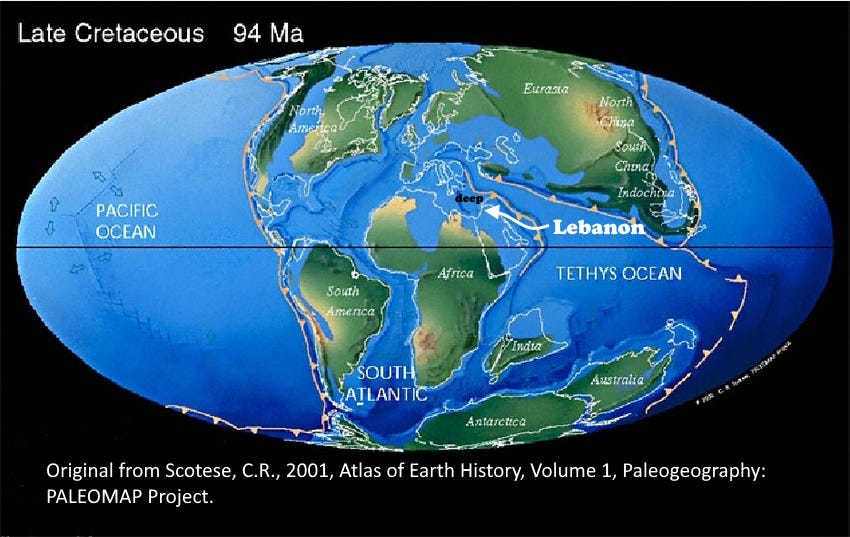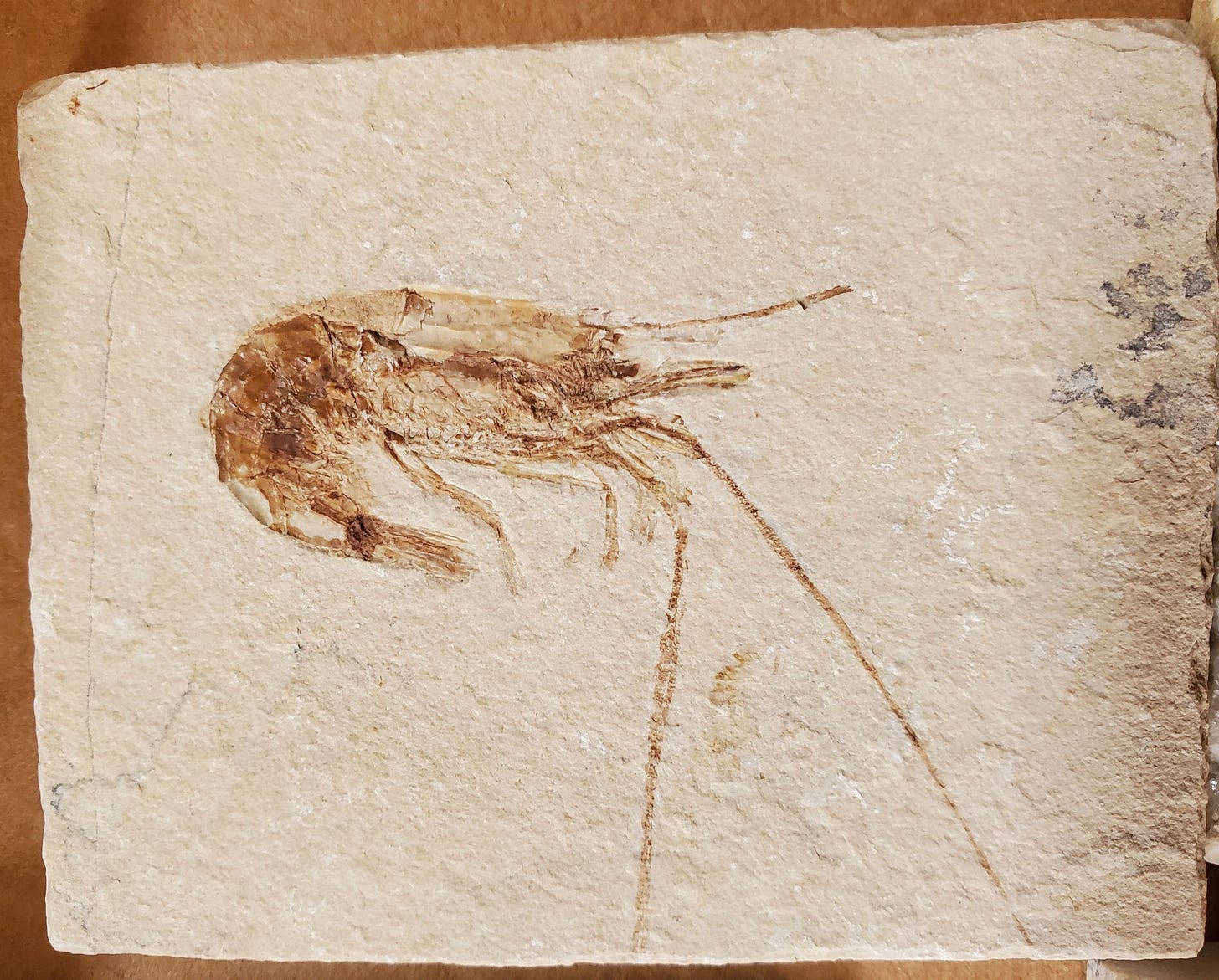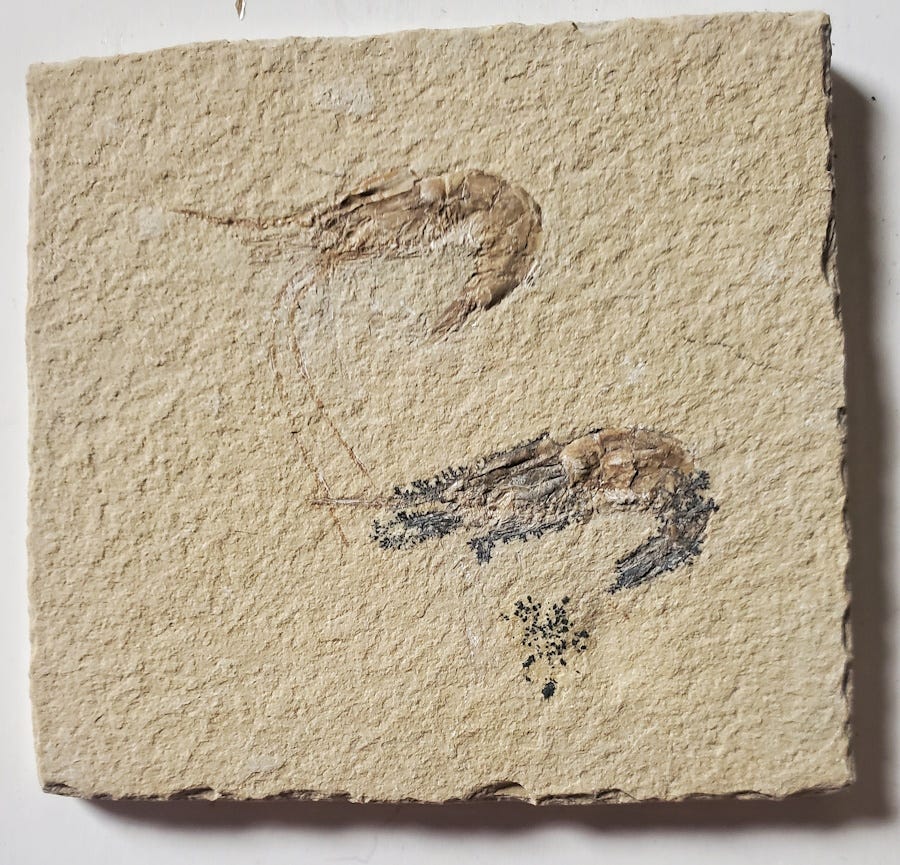Fossil fish were first reported from Lebanon by Herodotus about 450 B.C. This shrimp, Carpopenaeus callirostris, is from the Halek-Hadjula-Nammoura area about 45 km from Beirut.
The yellowish-tan limestone that so thoroughly preserves these fragile invertebrates is a fine-grained rock, a lithographic limestone remarkably similar to the Solnhofen Limestone of Germany, where the original Archaeopteryx was found. To be a lithographic limestone, suitable for engraving lithographic stones, the grain size should be uniform and on the order of one 250th of a millimeter.
The limestone and its fossils at Nammoura, Lebanon, are Cenomanian in age, the first stage of the Late Cretaceous about 98-99 million years ago. The rocks contain fish, insect fossils, and much more in addition to the shrimp for which they are famous. Lebanon during the Cenomanian was a moderately shallow, quiescent marine carbonate bank, perhaps similar to the western shelf of Florida (minus the hurricanes). The presence of insect fossils, land plant fossils, turtles, and pterosaur bones indicates the depositional setting was fairly near the shoreline (Maksoud and others, 2022, Palaeoentomological (fossil insects) outcrops in Lebanon: online publication, Paleopolis, Carnets Geol. 22:16).
The fine-grained uniform nature of the limestone indicates quiescent deposition. In addition, it’s likely that the water was (at least in its lower layers) both highly saline and low in oxygen, so predators and scavengers were rare or absent, and oxidation and degradation of the dead or dying animals and plants that fell to the water bottom did not occur readily, resulting in the excellent preservation. For a recent (2024) overview of the remarkable fossils at Nammoura and other nearby localities in Lebanon, see George and others, 2024, The famous fish beds of Lebanon: the Upper Cretaceous Lagerstätten of Haqel, Hjoula, Nammoura and Sahel Aalma: Journal of the Geological Society (London), 181 (5). The full paper is accessible here.
This deposit in Lebanon is a lagerstätte (German, from Lager 'storage' Stätte 'place', plural lagerstätten; from the same root that gives us lager beer, named for its cold storage for maturation), a sedimentary deposit that exhibits extraordinary fossils with exceptional preservation—sometimes including preserved soft tissues. The shrimp in my photos are about 3 cm long excluding the antennae and legs. In the photo at the bottom one shrimp has bits of probable black manganese oxide preferentially deposited on it. Cat. No. 2004-1 & 8.

Four million years later, toward the end of the Cenomanian, about 94 million years ago, the global ocean underwent a period of anoxia, low oxygen in the water, which produced an extinction event for marine species. Laugié and others (2021, Exploring the impact of Cenomanian paleogeography and marine gateways on oceanic oxygen: Paleoceanography and Paleoclimatology, 36:7) suggest that it was the configuration of lands and seas, the paleogeography, that led to the anoxic event through a constriction of the Pacific-Central Atlantic seaway, which had previously enhanced global oceanic circulation. That seaway was in the general area we think of as Central America today.
At that time, what is now Lebanon was near the edge of a broad shallow marine shelf that covered much of Arabia, but it was adjacent to a relatively isolated deep marine basin that was likely one of the areas impacted significantly by the end-Cenomanian anoxic event. If these shrimp had been alive then, there’s a good chance they would not have survived long. The shoreline that we inferred to be near the site of these fossils from 98 million years ago was further away by the end of the Cenomanian as shown on the map above, but the inferred anoxic conditions that helped preserve the shrimp had expanded across the globe, and probably included much shallow water as well as deeper oceanic basins.





